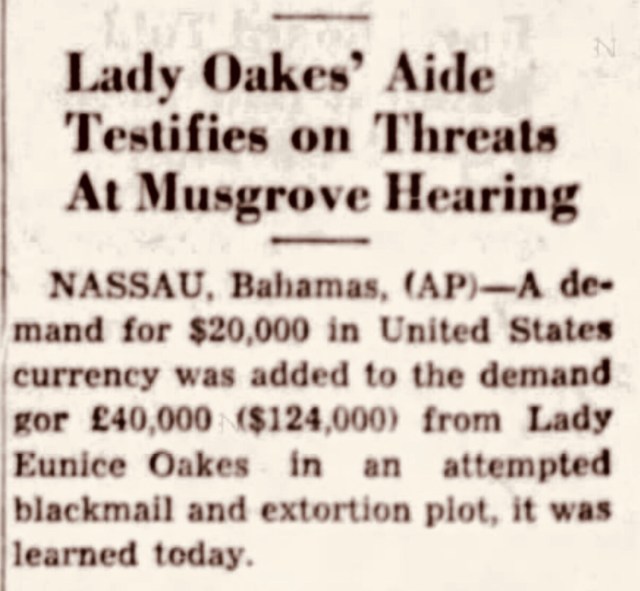
In the Bahamas, prior to 1950, the word extortion was probably used as much as the word Jupiter. Few knew what extortion, or even what Jupiter meant for that matter. After 1950, however, there was undoubtedly not a single Bahamian who didn’t understand that extortion meant a long custodial sentence, in Her Majesty’s Prison, at FoxHill.
By 1950, it had been just about seven years since the still unsolved murder of Sir Harry Oakes. Oakes, who made his fortune prospecting for gold, was one of the richest men in the world, and certainly the richest to have ever stepped foot in the Bahamas at that time. He was courted and feted by the Bahamian elite of the day as a way of encouraging him to stay in the islands and invest his money.
Harry Oakes did this.
Oakes, the gold millionaire, invested tremendous sums of money in the islands, but in turn, someone repaid him, by killing him in his own home when he was no longer useful to their cause.
Oakes had been murdered in his bed, at his estate, in Nassau, in 1943. His son-in-law was put on trial, but acquitted of his murder for lack of evidence.
Since 1943, talk of the Oakes murder had gone from shouts for justice, to whispers of who really did it, to a stone cold silence.
The silence was broken in April 1950, when the body of a woman, a white American lawyer, by the name of Betty Renner was found murdered in Nassau. Betty Renner had come to Nassau to investigate the murder of Sir Harry Oakes. She had been making claims of knowing who the real murderer was. Betty Renner’s half-clothed, battered body was found in an open well, in a quarry, in Nassau. Her murder would never be solved either.

(St. Louis Post-Dispatch, Thursday, 20 April 1950)
BETTY RENNER’S MURDER BRINGS OUT A BLACKMAILER AND EXTORTION PLOT
The murder of Betty Renner reignited seven years of speculation and intrigue surrounding the circumstances of the Oakes murder. It wasn’t long before everyone, from far and wide, were offering their theory on the link between the Oakes murder and the new Renner murder.

(The Daily News, New York, Sunday 02 July 1950)
One man, a negro taxi driver and church deacon, originally from Turks and Caicos, but living in Nassau some 22 years, decided that Lady Eunice Oakes, widow of Sir Harry Oakes, knew more than she was letting on. He decided that what she knew had a high monetary value attached to it. He decided to threaten her life if she didn’t pay him to be quiet, with what he knew about her, and her late husband, Sir Harry Oakes.
Nicholas Musgrove, a native of Turks Island, figured he could threaten the still grieving widow of the richest man The Bahamas had ever laid eyes on. Musgrove threatened Lady Oakes with bodily harm, and a bullet to the heart, if she didn’t pay him £40,000 ($124,000) he was demanding.
Musgrove thought that Lady Oakes would be so afraid of any supposed sordid details relating to Sir Harry becoming public that she would just keep quiet and pay whatever the deep voice on the telephone demanded.
Musgrove, the blackmailer and extortionist, was very wrong.
Captain Basil Sparrow, private secretary to Lady Oakes and the Bahamas police, quickly devised a trap for the would be blackmailer which would blow the extortion plot wide open.

(The Daily News, New York, Sunday 02 July 1950)



(The Windsor Star, Wednesday, 24 May 1950)
CHURCH DEACON AND TAXI DRIVER NOW ACCUSED BLACKMAILER LIVING IN A CONCRETE TWO STORY, SEVEN ROOM HOUSE AMID THE WOODEN SHACKS OF GRANTS TOWN
As soon as Deacon Nicholas Musgrove of the Eneas Street Church, now accused extortionist and blackmailer, was arrested, word quickly spread across Nassau.
Gossip was rife. Around every corner and on every street, people were talking.
In the negro community of Grants Town where Musgrove lived, preached and had a small grocery shop, opinions were divided. Where did a taxi driver and father of five get the kind of money needed to build a two story stone house amid the ramshackle, clapboard houses of Grants Town?
Some said he saved his money.
Others said he did worse.

(The Daily News, New York, Sunday 02 July 1950)
THE WHOLE SORDID STORY








(The Daily News, New York, Sunday 02 July 1950)
MUSGROVE ENTERS A ‘NOT GUILTY’ PLEA
TRIAL POSTPONED TO OCTOBER UNTIL KEY WITNESS RETURNED FROM AFRICA
Bail was set at $2,800.

(Tampa Bay Times, Thursday, 06 July 1950)
“If Lady Oakes doesn’t play ball with us we only have to pull one trigger to bleed her heart and another to burst her heart and it won’t be safe for her to come back here.”

SHORT EXTORTION TRIAL – RECORDED EVIDENCE USED FOR THE FIRST TIME AT TRIAL IN THE BAHAMAS



(Fort Lauderdale Daily News, Wednesday, November 15, 1950)
Musgrove Takes The Stand In His Own Defence, Contends One White Man Did It
The extortion trial began on Monday 13th November, 1950 and ended in under three short days on the 16th November.
When Nicholas Musgrove took the stand in his own defence, it was a risky move indeed considering he was caught red handed at the telephone booth from which the threatening/extortion phone call was made.
On the witness stand however, Musgrove offered that it was a case of mistaken identity. Musgrove contended that it was really an unidentifiable white man who had used the phone before him, who must be the real blackmailer and extortionist.
The Supreme Court jury did not believe his claim. Musgrove was found guilty and given a 5 year sentence. Chief Justice Oswald Bancroft also recommended that after his sentence, Nicholas Musgrove, be deported back to his native Turks and Caicos.


(The Ottawa Journal, Thursday 16 November 1950)






